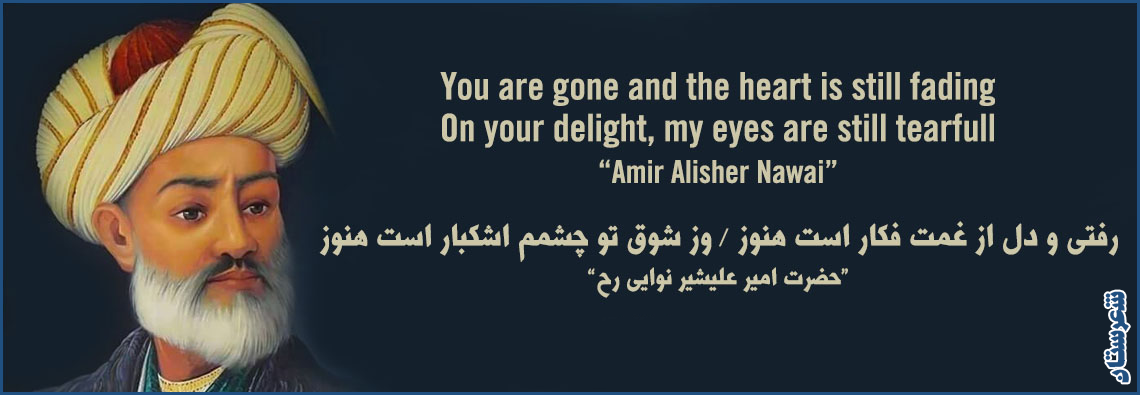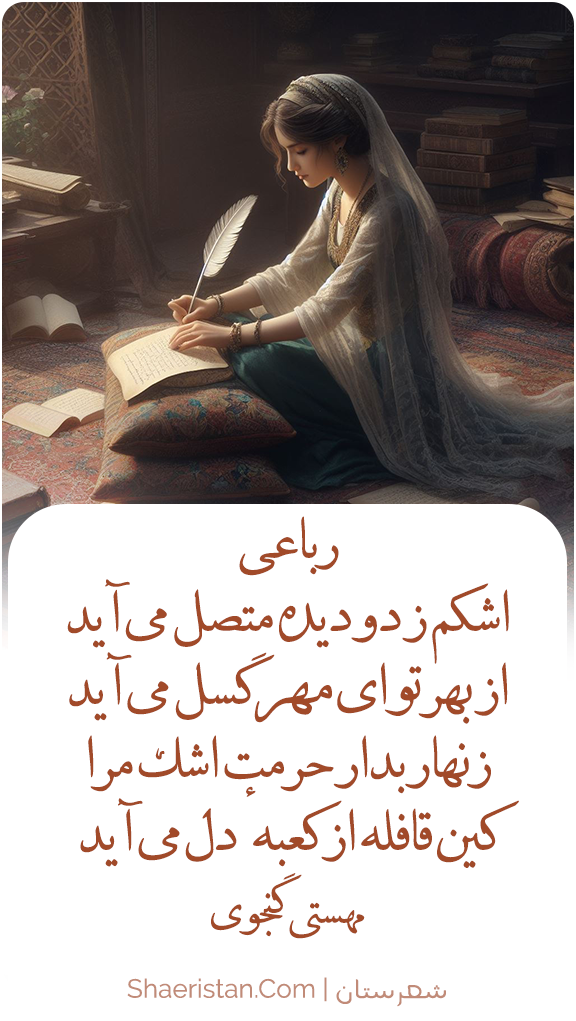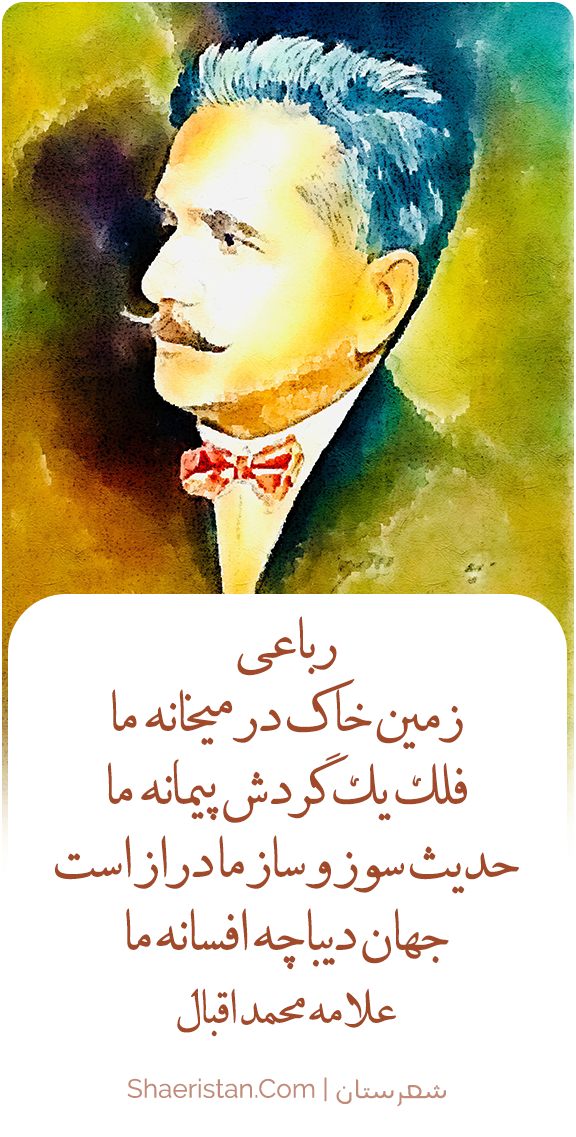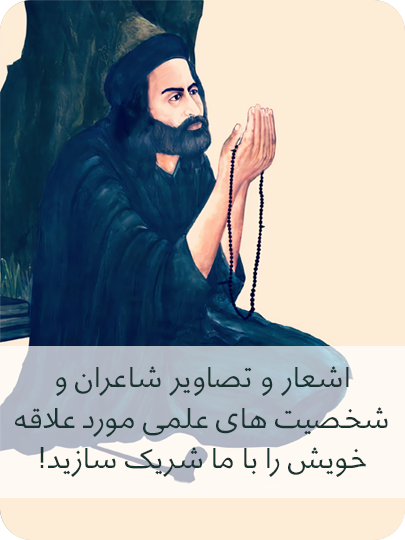
زندگینامه امیرعلی شیرنوایی
امیر علی شیر نوایی شاعر، دانشمند و وزیر سلطان حسین بایقرای گورکانی (۸۷۵ – ۹۱۱ ه. ق.) بود.
امیر علی شیر نوایی نام او علی شیر بن الوس یا کیچکنه یا کیچینه یا کجکنهٔ نوایی جغتایی و ملقب به «نظامالدین» است. از بزرگ زادگان خاندان جغتای , پسر چنگیزخان حاکم ماوراءالنهر و کاشغر و بلخ و بدخشان بود.
او مردی نیکوصفت و دانشمند و شاعر بوده اشعار بسیاری به دو زبان فارسی و ترکی جغتایی دارد به همین جهت مشهور به «ذوللسانین» بود. تخلص او در اشعار ترکی «نوایی» و در اشعار فارسی «فانی» یا «فنایی» است.
وی در سال ۸۴۴ ه. ق. در هرات متولد شد و تحصیلاتش اولیه خود را نزد پدرش کیچکینه بخشی -که از جمله وزرای تیموریان بود – کسب کرد و سپس برای ادامه تحصیل به سمرقند رفت. علی شیر در خردسالی با سلطان حسین میرزا که همدرس و هممدرسه بودهاند، عهد و پیمان بسته بودند که هر کدام به سلطنت برسد از حال دیگری تفقد نموده، فراموشش نکند , نوایی از آن پس به منظور تحصیل معارف و کمالات خوراسان و سمرقند و بسیاری از شهرهای دیگر را سیاحت کرد و در آن میان گرفتار فقر و فاقهای سخت شد. در این هنگام سلطان حسین میرزا در هرات به سلطنت نشست و به حکم همان پیمان قدیم، امیر علی شیر را از سمرقند فراخوانده منصب مهرداری خود را به وی واگذار کرد و اندکی پس از آن امر صدارت را نیز به او داد و بزرگی مقامش به جایی رسید که هر یک از برادران و فرزندان سلطان، ملازمت او را مایهٔ شرف و افتخار خود میدانستند و سلطان نیز بی مشورت او به هیچ کاری اقدام نمیکرد. اما علی شیر با وجود این همه مشاغل، از مطالعات علمی و تألیفات مختلف دست برنداشت و مجلس او مجمع علما و فضلای آن روزگار بود و کتابخانه وی نیز عمومی و مورد استفاده علاقمندان بود که از آنجمله خواندمیر مولف حبیبالسیر نیز از آن کتابخانه بهرهها برده است.
سرانجام وی از امور دولتی استعفا داده منزوی گشت و با ملا عبدالرحمان جامی مصاحب شد و درویشی را بر همه امور ترجیح داد. و در عین انزوا نیز مورد توجه سلطان حسین بوده و شاهزادگان موظف به استفاده از مجالس وی بودند. و عاقبت او به سال ۹۰۶ یا ۹۰۷ ه. ق. درگذشت.
کؤنگلیم اورتانسین اگر غیریغَه پروا ایلاسَه
هر کؤنگیل هم کیم سنینگ شوقینه پیدا ایلاسَه
اؤزگالار حسنین تماشا ایلاسَه٬ چیقسون کؤزؤم
اؤزگا بیر کؤز هم کی حسنینگنی تماشا ایلاسَه
غیر ذکری آشکارا قیلسا، لال اولسون تیلیم
قایسی بیر تیل هم کی ذکرینگ آشکارا ایلاسَه
ترجمه:
دلم آتش بگیرد اگر به کسی غیر از تو توجه کند. همچنین هر دلی (بهجز من) که عشق تو را داشته باشد.چنانچه چشمانم به جمال دیگر خوبرویان نظر کند، برکنده باد! همچنین هر چشم نامحرم که نظر به جمال تو داشته باشد.زبانم لال باد اگر صحبت از کسی جز تو کند. همچنین هر زبان بیگانهای که حدیث تو کند.
غربتدا غریب شادمان بولمَسایمیش
ایل اونگا شفیق و مهربان بولمَسایمیش
آلتین قفسایچره گر قیزیلگؤل بولسه
بولبولغه تیکَندَک آشیان بولمَسایمیش
ترجمه:
غریب در غربت شاد نمیگردد. مردم (آنجا) با وی صمیمی نیستند. چنانچه گل سرخ را در قفسی زرین نگه دارند، برایش مأوای مطلوبی نیست و حکم خار برای هزاردستان را دارد.
غزلیات | رباعیات | مقطعات | مسدس | مرثیه | فصول اربعه | ستهٔ ضروریه
اشعار متفرقه | تابلو های اشعار
![]()
BRIEF BIOGRAPHY OF AMIR ALI SHIR NAWAI
Alī Shīr Navāʾī, in full Mir ʿAlī Shīr Navāʾī, Navāʾī also spelled Nevāʾī, (born 1441, Herāt, Timurid Afghanistan—died January 3, 1501, Herāt), Turkish poet and scholar who was the greatest representative of Chagatai literature.
Born into an aristocratic military family, he studied in Herāt and in Meshed. After his school companion, the sultan Ḥusayn Bayqarah, succeeded to the throne of Herāt, Navāʾī held a number of offices at court. He was also a member of the Naqshbandī dervish order, and under his master, the renowned Persian poet Jāmī, he read and studied the works of the great mystics. As a philanthropist, he was responsible for much construction in the city. His other interests included miniature painting, music, architecture, and calligraphy.
Navāʾī devoted the latter part of his life to poetry and scholarship, writing first in Persian and then in Chagatai, an eastern Turkic dialect. He left four great divans, or collections of poems, belonging to different phases of his life.
He wrote five masnawis (series of rhymed couplets), collected in his Khamseh, that are based on conventional themes in Islamic literature, such as the story of Farhād and Shīrīn. His Lisān ul-tayr (1498; “The Language of the Birds”), an adaptation of Manṭeq al-ṭayr (The Conference of the Birds) by the Persian poet Farīd al-Dīn ʿAṭṭār, is also a masnawi.
One of Navāʾī’s most important prose works is Majālis-i nefaʾīs (1491; “The Exquisite Assemblies”), a tezkire (literary dictionary) that contains much autobiographical information and facts about the lives of Turkish poets. He also wrote a treatise on Turkish prosody. Navāʾī’s mastery of the Chagatai language was such that it came to be known as “the language of Navāʾī.”
![]()
Ali Sher Navai
Mir Ali Sher Navai (also spelled Nevai) (Uzbek: Alisher Navoiy also known as Nizamidin Alsher Nawai – (9 February 1441 – 3 January 1501) was a politician, mystic, linguist, painter, and poet. He was the greatest representative of Chagatai language (old Uzbek) literature. He significantly contributed to the development of the Uzbek language and is widely considered to be the founder of Uzbek literature.
Ali Shir Navai was born and lived in Herat. He is generally known by his pen name Navai- (meaning “melodic” or “melody maker”). Because of his distinguished Chagatai language poetry, he is considered by many throughout the Turkic-speaking world to be the founder of early Turkic literature. Many places and institutions in Uzbekistan and other Turkic countries are named after Ali Shir Navai. Navoiy Province, the city of Navoiy, the National Library of Uzbekistan named after Alisher Navoiy, the Alisher Navoi Opera and Ballet Theatre, and Navoiy Airport — all are named after him. Many of Navai’s ghazals have become part of Uyghur 12 Muqam and popular Uzbek folk songs and, especially by Sherali Jorayev, and his works have been staged as plays by Uzbek playwrights.
Life: Mir Ali Sher Navai was born in 1441 in Herat, which is now in northwestern Afghanistan. During Mir Ali Shir’s lifetime, Herat was the capital of the Timurid Empire and became one of the leading cultural and intellectual centers in the Muslim world. Ali Shir belonged to the Chagatai amir (or Mir in Persian) class of the Timurid elite. His father, Ghiya-th ud-Din Kichkina (“the Little”), served as a high-ranking officer in the palace of Shahrukh Mirza, the ruler of Khorasan. Although all applications of modern Central Asian ethnonyms to people of Navai’s time are anachronistic, some sources regard Mir Ali Shir as an ethnic Uzbek. Maria Subtelny has proposed that Ali Shir Nava’i was a descendant of Bakhshi scribes, which has led some sources to call Nava’i “Uyghur”, but this view is refuted by Kazuyuki Kubo.
Ali Shir’s mother served as a princes’ governess in the palace. His father served as governor of Sabzawar at one time. He died while Mir Ali Sher was young, and the ruler of Khorasan, Babur Ibn-Baysunkur, adopted guardianship of the young man.
Mir Ali Sher was a schoolmate of Husayn Bayqarah, who would later become the sultan of Khorasan. Ali Sher’s family was forced to flee Herat in 1447 after the death of Shahrukh created an unstable political situation. His family returned to Khurasan after order was restored in the 1450s. In 1456 Ali Sher and Bayqarah went to Mashhad with Ibn-Baysunkur. The following year Ibn-Baysunkur died and Ali Sher Bayqarah parted ways. While Bayqarah tried to establish political power, Ali Sher pursued his studies in Mashhad, Herat, and Samarkand. After the death of Abu Said in 1468, Husayn Bayqarah seized power in Herat. As a result Ali Sher left Samarkand to join his service. Bayqarah ruled Khurasan almost uninterruptedly for forty years. Ali Sher remained in the service of Bayqarah until his death on 3 January 1501. He was buried in Herat.
Ali Sher Navai – led an ascetic lifestyle, never marrying or having concubines or children.
Work: Mir Ali Sher served as a public administrator and adviser to his sultan, Husayn Bayqarah. He was also a builder who is reported to have founded, restored, or endowed some 370 mosques, madrasas, libraries, hospitals, caravanserais, and other educational, pious, and charitable institutions in Khorasan. In Herat, he was responsible for 40 caravanserais, 17 mosques, 10 mansions, 9 bathhouses, 9 bridges, and 20 pools.
Among his most famous constructions were the mausoleum of the 13th-century mystical poet, Farid al-Din Attar, in Nishapur (northeastern Iran) and the Khalasiya madrasa in Herat. He was one of the instrumental contributors to the architecture of Herat, which became, in Rene’ Grousset’s words, “the Florence of what has justly been called the Timurid Renaissance”. Moreover, he was a promoter and patron of scholarship and arts and letters, a musician, a composer, a calligrapher, a painter and sculptor, and such a celebrated writer that Bernard Lewis, the distinguished English historian of Islam, called him “the Chaucer of the Turks”
Literary works: Under the pen name Navai, Mir Ali Sher was among the key writers who revolutionized the literary use of the Turkic languages. Navai – himself wrote primarily in the Chagatai language and produced 30 works over a period of 30 years, during which Chagatai became accepted as a prestigious and well-respected literary language. Navai also wrote in Persian (under the pen name Fani), and to a much lesser degree in Arabic and Hindi.
Navai’s best-known poems are found in his four divans, or poetry collections, which total roughly 50,000 verses. Each part of the work corresponds to a different period of a person’s life:
Ghara’ib al-Sighar (“Wonders of Childhood”)
Navadir al-Shabab (“Rarities or Witticisms of Youth”)
Bada’i’ al-Wasat (“Marvels of Middle Age”)
Fawa’id al-Kibar (“Advantages of Old Age”)
To help other Turkic poets he wrote technical works such as Mizan al-Awzan (“The Measure of Meters”), and a detailed treatise on poetical meters. He also crafted the monumental Majalis al-Nafais (“Assemblies of Distinguished Men”), a collection of over 450 biographical sketches of mostly contemporary poets that is a gold mine of information for modern historians of Timurid culture.
Navai’s other important works include the Khamsa (quintuple), which is composed of five epic poems and an imitation of Nizami Ganjavi’s Khamsa:
Hayrat-ol-abrar (Wonders of Good People)
Farhad va Shirin (Farhad and Shirin)
Layli va Majnun ( Layli and Majnun)
Sab’ai Sayyar (“Seven travellers (planets)”)
Sadd-i-Iskandari (“Alexander’s Dam”, an epic poem about Alexander the Great)
He also wrote Lison ut-Tayr (“Language of Birds”, following Attar’s Manteq-ol-tayr or Speeches of Birds), in which he expressed his philosophical views and Sufi ideas. He translated Jami’s Nafahat-ol-ons to Chagatai Turkic and called it Nasayim-ul-muhabbat. Hi Besh Hayrat (Five Wonders) also gives an in-depth look at his views on religion and Sufism. His book of Persian poetry contains 6000 lines (beit).
Navai’s last work, Muhakamat al-Lughatayn (“The Trial of the Two Languages”) is a comparison of Turkic and Persion and was completed in December 1499. He believed that the Turkic language was superior to Persian for literary purposes, and defended this belief in his work. Nava’i repeatedly emphasized his belief in the richness, precision and malleability of Turkic vocabulary as opposed to Persian. The Muhakamat acted as the author’s last will and testament.
List of Works: Below is a list of Ali Sher Navai’s works compiled by Suima Ganieva, a senior professor at the Tashkent State Institute of Oriental Studies.
Badoe ul-Vasat – The third devon (a complete collection of poems) of Navoi’s lyric heritage “Hazoin-ul-maoniy”. It consists of 650 ghazals, 1 mustazod, 2 muhammas, 2 musaddas, 1 tarjeband, 1 qasida (an ode – triumphal poem praising a person or event), 60 qit’as, 10 chistons, 3 tuyuks. Total number is – 740 poems – 5420 couplets, compiled between 1492–1498 years.
Waqfiya – Alisher Navoi wrote it in 1481. This is a documentary work by ‘Foni’ but it also depicted the poet’s life, spiritual world, his dreams and unfulfilled desires. The work is an important source of information about economic, social and cultural life in the 15th century.
Layli wa Majnun – The third dastan (epic poem) of “Hamsa” (“Quintet”, a group of five dastans). It is about a man mad with love. It was written in 1484 and consists of 3622 couplets and 36 chapters.
Lison ut-Tayr ( The Language of the Birds ) – An epic poem that is an allegory for our need to seek God, whatever our excuses may be. The story begins with the birds of the world realizing that they are far from their king and need to seek him. They begin the long and hard journey with many complaints, but a wise bird encourages them through admonishment and exemplary stories. It was written in 1498-99, and consists of 3598 couplets. In the introduction Navoi noted he wrote this epic poem as a response to “Mantiq-ut Tayr” by Fariduddin Attar and used the pseudonym “Foniy”.
Majolis un-Nafois – is Navoi’s tazkira (anthology). Written in 1491-92, completed with additions in 1498. It consists of eight meeting reports, tells about contemporary poets, especially major contemporary ones. Overall, Navoi provides information about 459 poets and authors. The work was translated three times and again into Persian in the 16th century. Translated into Russian – volume nine.
Mahbub ul-Qulub – Alisher Navoi’s work written in 1500 – the last year before his death. Here the poet’s extremely rich experience and conclusions are collected into one work. It consists of an introduction and three parts. The first part is about status and the duty of different social classes; the second part is about moral matters; the third part provides useful advice and wise sayings. Translated into Russian – volume ten.
Mezon ul-Avzon – Navoi’s work about Persian and Turkic aruz. It was created in 1490.
Minhoj un-Najot (The ways of salvation) – The fifth poem of the Persian triumphal poems collection “Sittai zaruriya” (6 necessities). It consists of 138 couplets. It was written in response to Khoqoni and Ansori’s triumphal poems.
Munojot – is a work written by Navoi in the last years of his life. It is a small work about pleading and repenting before Allah. The poet’s unfulfilled dreams and regrets connected to epoch and environment, anxiety in his spirit is depicted dependently with incomplete surrounding. The work is written in prose with saaj. Translated into Russian and English (1990).
Munshaot (A Collection of Letters) – A collection of letters of Navoi written to different classes of people about various kinds of matters. There are also letters addressed to Navoi in this collection. It was collected in 1498-99. The work contains details about Khusain Baykaro, Badiuzzamon Mirzo and the letters addressed to his adopted son and letters expressing his dreams about doing the pilgrimage to Ka`bah. This work gives valuable facts about political, social, moral and spiritual matters for the common person.
Mufradot – Navoi’s work about how to do problem-solving. The ways of making and solving of 121 problems are depicted in this work . There are 52 problems in Chagatay in the Hazoin-ul-maoni section and 500 problems in Persian in Devoni Foni section. The work was written in 1485, a presentation of various views and styles of problems is given.
Muhakamat ul-Lughatain – Navoi presents the contexts, the vocabulary and other possibilities that bode well for the fiction/poetic work of Turkic over the Persian language. Included are details about poets who write in both languages. This work by Navoi proves how he struggled for a national language and a national literature. It was written in 1499.
Navodir ush-Shabob (The Valuables of Youth) – Navoi’s second devon (complete collection of poems) and includes Hazoin-ul-maoniy . It contains 650 ghazals, 1 mustazod, 3 muhammas, 1 musaddas, 1 tarjeband, 1 tarkibband, 50 qit`as, and 52 problems. Total number is: 759 poems and 5423 couplets. It was formed 1492-1498.
Nazm ul-Javohir – In 1485 Navoi wrote this work in appreciation of Khusain Baykaro’s Risola . The meaning of every proverb in Hazrat Ali’s collection of proverbs entitled Nasr ul-laoliy is told in one ruba’i. The creation and purpose of the work is given in the preface.
Nasim ul-Huld – Navoi’s qasida (ode) written in Persian under the influence of Khoqoni and Khisrav Dehlavi’s qasidas. Early Russian Navoi expert E. Bertels wrote that it was a response to Jomi’s Jilo ur-ruh.
Risolai tiyr andohtan – In E. Bertels’ book “Navoi” he posits this work in the 22nd place in his list of 22 works by Navoi. The work (Risola) was inserted in Navoi’s non-completed “Kulliyot”, which was published as a book in 1667-1670 and consisted of 17 works. Risola consists of three pages and seems to be a commentary on one of the hadiths. For the first time it was published in 1995 in the “Tafakkur” magazine, in Uzbekistan.
Rukh ul-Quds (Holy Spirit) – The first qasida (ode) of Navoi’s collection of qasidas in Persian named “Sittai zaruriya”. It consists of 132 couplets and is about divine love.
Sab`ai Sayyor (Travel Around the Planets) – The fourth dastan (epic poem) of “Hamsa” by Navoi. It is divided into 37 chapters and consists of 8005 lines. It was written in 1485.
Saddi Iskandari (The Wall of Alexander the Great) – The fifth dastan (epic poem) of “Hamsa” by Navoi. This masterpiece displays Navoi’s view of governance. Alexander the Great conquers the world not for self-glory, but for protecting the people (world justice). It consists of 88 chapters and 7215 couplets. Written in 1485.
Siroj ul-Muslimin (The Light of Muslim People) – Alisher Navoi’s work written in 1499. It gives the facts about the five pillars of Islam, Shari’at, the rule of faith, signs of God, responsibilities and the sunnats of namaz (the five daily prayers), purity, alms, fasting and the Hajj. The risola (pamphlet) was first published in Uzbekistan in 1992.
Tarixi muluki Ajam – Navoi’s work written in 1488 dedicated to outlining a history of the Shahs of Iran. The work describes the useful deeds of the Shahs done for their society and people, starting from Kayumars to Yazdijurd Shahriyor that belonged to four classes (dynasties).
Tuhfat ul-Afkor – Navoi’s qasida (ode) in Persian written as a respond to “Daryoi abror” by Khisrav Dehlavi. One of the six qasidas named “Sittai zaruriya”. While writing this work he also was influenced by Jomi’s qasida “Lujjat ul-asror”, which he wrote as a respond to Khusravs.
Favoid ul-Kibar (The Usefulness of Old Age) – The fourth diwan (complete collection of poems) of “Hazoin ul-maoniy” by Navoi. It consists of 650 ghazals, one mustazod, two muhammas, one musaddas, one musamman, one tarje`band, one sokiynoma, 50 qit`a, 80 fard, 793 poems, 5888.5 couplets. Written 1492-1498.
Farhod wa Shirin (Farhad and Shirin) – The second epic poem of “Hamsa” by Navoi. A classic Romeo and Juliet story for Central Asians. Divided into 59 chapters, 5782 couplets. Written in 1484.
Fusuli arba`a (Four seasons) – The common name of four qasidas (odes) written in Persian by Navoi. Each Qasida is about one of the four seasons – Spring (57 couplets), Hottest part of Summer (71 couplets), Autumn (35 couplets), and Winter (70 couplets).
Hazoin ul-Maoniy – The common name of the four diwans (complete collection of poems) that include completed lyrical poems by Navoi. “Hazoin ul-maoniy” consists of 2600 ghazals, four mustazods, ten muhammas’, four tarje`bands, one tarkibband, one masnaviy (a poetic letter to Sayyid Khsan), one qasida, one sokiynoma, 210 qit`as, 133 ruba’is, 52 muammos, 10 chistons, 12 tuyuks, 26 fards, 3132 poems – 22450, 5 couplets (44901 misra’s (poetry couplet ). The work was finished in 1498. In this collection 16 different lyrical genres are presented.
Hamsa – The common name of five dastans (epic poem) by Navoi written in 1483-85. With this work Navoi established a precedent for quality literature in Chagatay. The dastans are:
a. “Hayrat ul-Abror”, 64 chapters, 3988 couplets
b. “Farhad wa Shirin”, 59 chapters, 5782 couplets, written in 1484
c. “Layli wa Majnun”, 36 chapters, 3622 couplets
d. “Sab`ai Sayyor”, 37 chapters, 8008 couplets, written in 1485
e. “Saddi Iskandari”, 83 chapters, 7215 couplets, written in 1485
Ashraf, a poet from Khirat (died in 1450-51) wrote a “Hamsa” as well. His work included the dastans – “Minhaj ul-Abror”, “Haft avrang”, “Riyaz ul-oshiqin”, “Ishqnama”. The last dastan about Iskandar hadn’t been completed.
Hamsat ul-Mutaxayyirin – Alisher Navoi’s work about Abdurahmon Jomi written in 1494. It contains an introduction, three parts and a conclusion. In the introduction Jomi’s genealogy, his birth, upbringing, studies, his becoming a scientist and poet is explained. The first part tells about Jomi’s spiritual world, and his talks concerning creative works; the second part reveals the nearness between Navoi and Jomi in creative colloborations, talks and invitations to works relating to Sufism. The conclusion sheds light on Jomi’s death. It includes Navoi’s eulogy written in Persian that consists of seven sections of ten lines.
Gharoyib us-Sighar – The first diwan (complete collection of poems) of “Hazoin ul-Maoniy” by Navoi. It consists of 650 ghazals, one mustazod, three muhammas, one musaddas, one tarje`band, one masnaviy, 50 qit`as, 133 ruba’is. 840 poems – 5718,5 couplets (11.437 misra). It was compiled 1492-1498.
Hayrat ul-Abror – The first dastan (epic poem) of “Hamsa” by Navoi. It’s divided into 64 chapters, and has 3988 couplets. Written in 1483.
Influence of Navai: Navai had a great influence in areas as distant as India to the east and the Ottoman Empire to the west.
Babur (1483-1530), founder of the Mughal Empire in India, wrote one of the first autobiographies among Islamic rulers, the epic “Baburnama”. He was influenced heavily by Navai and even includes his respect for the writer in this famous book.
The Ottomans were highly conscious of their Central Asian heritage; Suleyman the Magnificent was impressed by Navai and had the Divani Nevai, Khamsa and Muhakamat added to his personal library.
The renowned Azerbaijani poet Fuzuli, who wrote under the auspices of both the Safavid and Ottoman empires, was heavily influenced by the style of Navai.
Further influence can be found in Kazan of Russia, Turkistan/Central Asia, modern day Turkey and all other areas which Turkic speakers inhabit.
He is considered the national poet of Uzbekistan in Uzbek culture.
Navai is one of the most beloved poets in the Turkic-speaking world. His mastery of the Chagatai language was such that that it became known as “the language of “Navai”.






